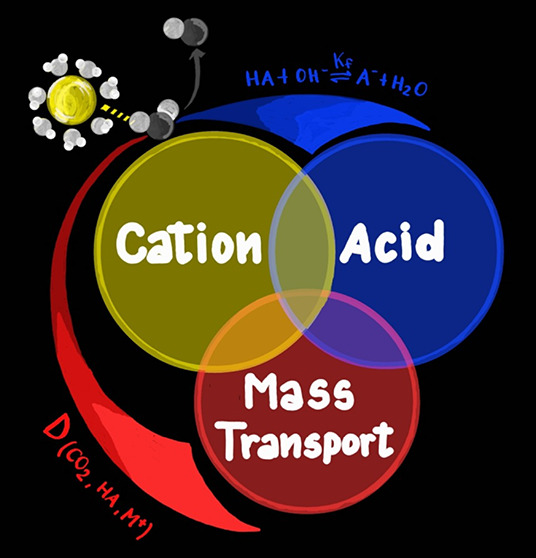- Record: found
- Abstract: found
- Article: found
Electrolyte Effects on CO 2 Electrochemical Reduction to CO

Read this article at
Conspectus

The electrochemical reduction of CO 2 (CO2RR) constitutes an alternative to fossil fuel-based technologies for the production of fuels and commodity chemicals. Yet the application of CO2RR electrolyzers is hampered by low energy and Faradaic efficiencies. Concomitant electrochemical reactions, like hydrogen evolution (HER), lower the selectivity, while the conversion of CO 2 into (bi)carbonate through solution acid–base reactions induces an additional concentration overpotential. During CO2RR in aqueous media, the local pH becomes more alkaline than the bulk causing an additional consumption of CO 2 by the homogeneous reactions. The latter effect, in combination with the low solubility of CO 2 in aqueous electrolytes (33 mM), leads to a significant depletion in CO 2 concentration at the electrode surface.
The nature of the electrolyte, in terms of pH and cation identity, has recently emerged as an important factor to tune both the energy and Faradaic efficiency. In this Account, we summarize the recent advances in understanding electrolyte effects on CO2RR to CO in aqueous solutions, which is the first, and crucial, step to further reduced products. To compare literature findings in a meaningful way, we focus on results reported under well-defined mass transport conditions and using online analytical techniques. The discussion covers the molecular-level understanding of the effects of the proton donor, in terms of the suppression of the CO 2 gradient vs enhancement of HER at a given mass transport rate and of the cation, which is crucial in enabling both CO2RR and HER. These mechanistic insights are then translated into possible implications for industrially relevant cell geometries and current densities.
Related collections
Most cited references76
- Record: found
- Abstract: found
- Article: not found
What would it take for renewably powered electrosynthesis to displace petrochemical processes?
- Record: found
- Abstract: found
- Article: not found
Catalysts and Reaction Pathways for the Electrochemical Reduction of Carbon Dioxide.
- Record: found
- Abstract: found
- Article: not found